| Article ID | Journal | Published Year | Pages | File Type |
|---|---|---|---|---|
| 4675985 | Cold Regions Science and Technology | 2012 | 12 Pages |
In snow-rich areas, snow avalanches endanger settlements and cause heavy damage to infrastructure or transportation routes. In wooded avalanche paths, dendrogeomorphology has been used extensively to reconstruct snow avalanche histories or to complement existing archival records. Several authors noted (i) that avalanche chronologies reconstructed from tree rings would depend on the number of trees sampled, and on (ii) the minimum number of tree-ring responses; and (iii) that they would always represent minimum frequencies. These restrictions gave rise to the question of how much of the real avalanche activity can be captured in tree-ring records. We therefore performed a dendrogeomorphic analysis based on 175 Larix decidua Mill. and 34 Picea abies (L.) Karst. trees from an extensively and accurately documented (1905–2010) avalanche path located in the Arve valley (French Alps) to obtain optimal thresholds for sample size and index values (i.e. percentage of responses in relation to the number of trees alive for a given year). Results clearly demonstrate that a sample size of ~ 100 trees is needed to obtain the best match between reconstruction (tree rings) and documentation (archives) while minimizing the inclusion of noise in the dendrogeomorphic record. Validation of the reconstruction (1771–2010) with historical archives shows that 13 undocumented events could be added to the archival record and that 43% of all documented events were deciphered with dendrogeomorphic techniques. The reconstruction of the spatial extent and reach of past snow avalanches matches with historical archives as far as the longitudinal extent of the largest avalanches is concerned. Yet, tree-ring records tend to underestimate runout elevations for a majority of minor events. Large discrepancies are also reported between the lateral limits derived with dendrogeomorphic techniques and the data reported in historical reports and hazard maps, with tree-ring data suggesting larger lateral spread of avalanche snow.
► Avalanche chronologies reconstructed from tree rings depend on several thresholds. ► Comparison tree-ring reconstruction/archives for an unusually well-documented path. ► Best match between reconstruction and archives is obtained with higher sample depth. ► Tree-ring analysis add substantially to the historic record for the area. ► Dendrogeomorphic methods are powerful to reconstruct the lateral spread of avalanches.
